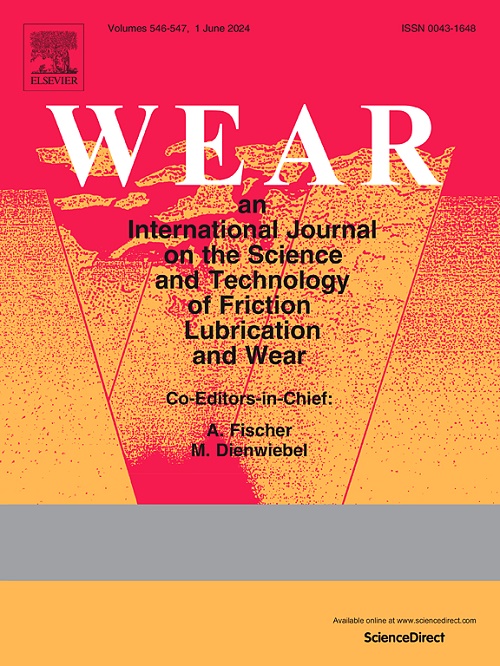聚合物-金属界面多粗糙度磨损与传递的统计建模
IF 5.3
1区 工程技术
Q1 ENGINEERING, MECHANICAL
引用次数: 0
摘要
现有的基于第一性原理的模型主要解决了单一性相互作用;然而,对多个接触颗粒的行为仍然没有充分的了解。本研究以氧化铝/聚四氟乙烯(PTFE)复合材料为研究对象,研究了干摩擦条件下多粗糙度界面的粘接磨损行为和材料传递机制。采用Rabinowicz临界尺寸准则和蒙特卡罗模拟方法,分析了非晶石的统计磨损特性。研究结果表明,模拟磨损系数接近10−4,与实验值吻合良好。此外,在稳态磨损过程中,粗糙度大小、材料性能及其分布对聚合物的磨损行为和材料流动有重要影响。这项研究为干摩擦界面的复杂相互作用提供了新的见解,为优化材料设计和性能铺平了道路。本文章由计算机程序翻译,如有差异,请以英文原文为准。
Statistical modeling of multi-asperity wear and transfer in polymer-metal interfaces
Existing first-principle-based models have primarily addressed single-asperity interactions; however, the behavior of multiple contacting asperities remains inadequately understood. This study investigates the adhesive wear behavior and material transfer mechanisms of a multi-asperity interface in dry friction conditions, focusing on an alumina/polytetrafluoroethylene (PTFE) composite. By applying Rabinowicz's critical size criterion and Monte Carlo simulations, we analyzed the statistical wear characteristics of asperities. Our findings indicate that the simulated wear coefficient approximates 10−4, aligning well with experimental values. Additionally, the asperity size, material property, and their distribution strongly affect polymer wear behavior and material flow during the steady-state wear period. This research offers novel insights into the complex interactions at dry friction interfaces, paving the way for optimized material design and performance.
求助全文
通过发布文献求助,成功后即可免费获取论文全文。
去求助
来源期刊

Wear
工程技术-材料科学:综合
CiteScore
8.80
自引率
8.00%
发文量
280
审稿时长
47 days
期刊介绍:
Wear journal is dedicated to the advancement of basic and applied knowledge concerning the nature of wear of materials. Broadly, topics of interest range from development of fundamental understanding of the mechanisms of wear to innovative solutions to practical engineering problems. Authors of experimental studies are expected to comment on the repeatability of the data, and whenever possible, conduct multiple measurements under similar testing conditions. Further, Wear embraces the highest standards of professional ethics, and the detection of matching content, either in written or graphical form, from other publications by the current authors or by others, may result in rejection.
 求助内容:
求助内容: 应助结果提醒方式:
应助结果提醒方式:


